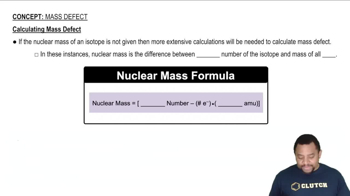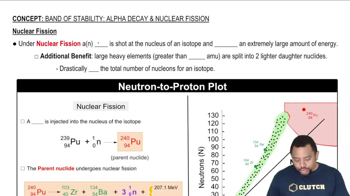Here are the essential concepts you must grasp in order to answer the question correctly.
Mass Defect
The mass defect is the difference between the mass of an atomic nucleus and the sum of the individual masses of its protons and neutrons. This discrepancy arises because some mass is converted into energy during the formation of the nucleus, according to Einstein's equation E=mc². The mass defect is crucial for understanding nuclear stability and is typically expressed in atomic mass units (u) or grams per mole (g/mol).
Recommended video:
Binding Energy
Binding energy is the energy required to disassemble a nucleus into its constituent protons and neutrons. It is directly related to the mass defect, as the energy equivalent of the mass defect represents the binding energy of the nucleus. Binding energy is often expressed in mega-electronvolts per nucleon (MeV/nucleon), providing insight into the stability of the nucleus; a higher binding energy indicates a more stable nucleus.
Recommended video:
Nuclear Stability
Nuclear stability refers to the ability of a nucleus to remain intact without undergoing radioactive decay. It is influenced by the balance between the attractive nuclear force, which holds protons and neutrons together, and the repulsive electromagnetic force between protons. Nuclei with higher binding energies per nucleon are generally more stable, as they are less likely to break apart, making the comparison of binding energies essential for assessing stability.
Recommended video:
Band of Stability: Nuclear Fission
 Verified step by step guidance
Verified step by step guidance


